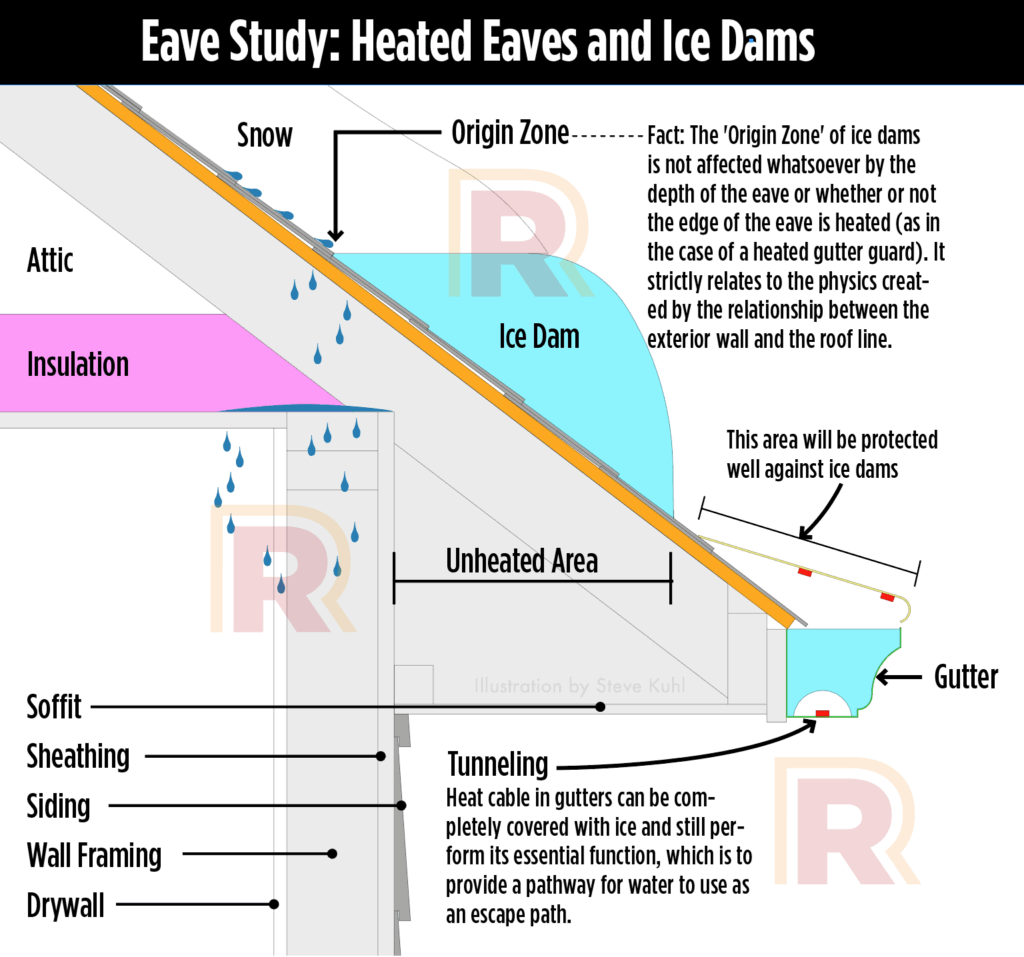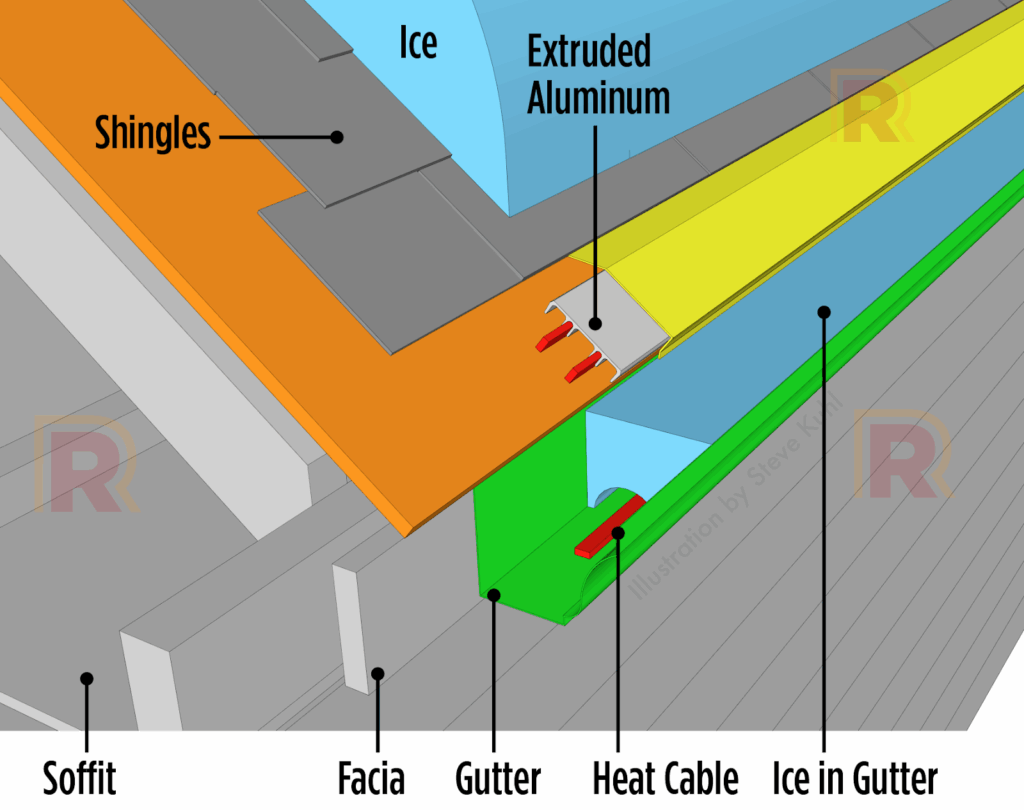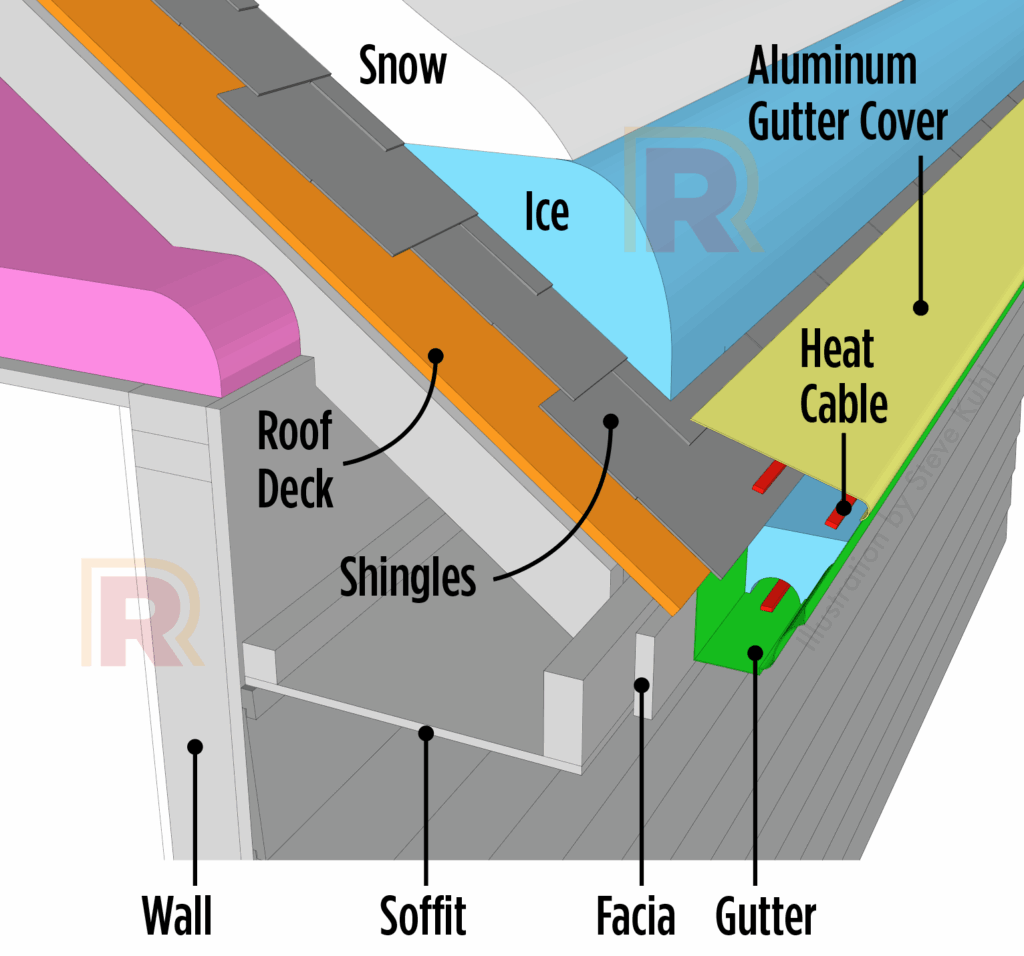Gutter Guards, Heat Cable and Ice Dams
The short answer? Not really. While heated gutters and gutter guards create a tunnel for water drainage, they don’t address where ice dams actually form – on the roof itself, above your exterior walls. Understanding this distinction can save you thousands of dollars in ineffective solutions and potential damage.
Where Ice Dams Actually Form on Your Roof
Ice dams don’t start at your gutters. They form upslope on the warm part of your roof, directly above your exterior walls, in what we call the Origin Zone.
Here’s what actually happens: Heat loss from your home’s interior warms the roof deck above the exterior wall’s top plate, melting the snow there. This meltwater then runs down to the unheated eave and refreezes, building the dam. As building science experts explain, heat loss “from the home or building…warms the roof deck and causes snow to melt. When this snowmelt reaches the eaves, it freezes…leading to a buildup of ice and a backup of water.”
The key point: ice dams form in the roof area above the cold overhang, not at the gutter edge. This is why installing heat at the gutter alone cannot prevent the dam at its source above.
What Happens When You Put Heat Cable in a Gutter
A heat cable in your gutter creates what we call tunneling – it melts a narrow channel around itself, but it doesn’t eliminate the ice dam. Think of it like drilling a small hole through a wall rather than removing the wall entirely.
Ice dam professionals confirm that heating cables “melt small channels through snow and ice in an effort to provide a path for melted ice and water to run off of the roof.” The cable performs an essential function by creating an escape path for meltwater, but it doesn’t solve the root cause.
This process works in different gutter types:
- Sheet Metal Gutters: Heat cable creates a tunnel through accumulated ice
- Extruded Aluminum Gutters: Cable melts contact ice, forming drainage channels
While this tunneling helps reduce water backup, the ice dam itself remains largely intact on your roof.
Why Heated Gutters Still Allow Ice Dams to Form
Because ice dams form on the roof above your walls, warming just the gutter doesn’t stop them. A heat cable in the gutter heats only the metal of the gutter (or guard) and maybe nearby ice, but it does nothing to warm the roof deck above the wall where the dam originates.

Roofing experts warn that “installing heat cable in gutters alone will NOT prevent ice dams…Ice dams are roof phenomena and will occur on the roof regardless of whether or not gutters are present.”
The dam forms in the same location whether you have:
- No gutters at all
- Standard gutters
- Heated gutters
- Any wattage heat cable in the gutter
Because the heated gutter only warms the gutter itself – not the cold shingles above the wall – it cannot stop the dam from forming at the origin.
How Heated Eave Systems Actually Work
Sheet metal or extruded aluminum eave systems distribute heat through conduction a certain distance from the heat cable. Three variables affect this heat transfer:
| Factor | Impact on Heat Transfer |
| Ambient Temperature | Lower temps decrease heat transfer distance |
| Cable Wattage | Higher wattage creates more aggressive heat distribution |
| Material Thickness | Massive aluminum bodies transfer heat much better than thin sheet metal |
The heat transferred to the aluminum doesn’t travel beyond the aluminum form itself. Therefore, only ice directly in contact with the heated metal will melt.
Comparison of Heated System Types
| System Type | Heated Zone Coverage | Heat Transfer Medium | Effectiveness Notes |
| Gutter-only Heat Cable | Gutter and immediate ice contact | Metal gutter only | Creates a small melt channel; does not prevent ice dams above the origin zone |
| Thin Sheet Metal (clamp-on) | Limited upslope (few inches) | Low-mass sheet metal | Provides minimal heat spread; sufficient only in mild winters |
| Extruded Aluminum Eave Panel | Extends 6–18 inches upslope | High-mass extruded aluminum | Heats origin zone effectively; spreads heat evenly; suited for heavy snow climates |
What Makes Heated Eave Systems Effective for Ice Dam Prevention
An effective ice dam prevention system must actively heat the entire Origin Zone of the roof – not just the gutter. In practice, this means the heated metal panel must extend upslope far enough to cover the warm zone above the wall.
The 6-18 Inch Rule
Many installers follow specific guidelines for eave system coverage:
- Minimum 6 inches up the roof from the wall line
- Up to 18 inches for wider eaves or severe climate conditions
- Some factory panels extend over a foot to eliminate ice on eaves up to 18″ wide
Material Quality Matters
Extruded Aluminum Panels:


- Use thick, thermally conductive aluminum extrusions
- Heat a mass that conducts energy efficiently
- Experienced installers note these systems “heat a mass that is thermally conductive rather than letting that energy be immediately consumed by the atmosphere”
Thin Sheet Metal Gutter Guards (Limited effectiveness):


- Far less heat capacity
- Usually only sufficient for mild winters
- Energy dissipates quickly to the atmosphere
Proper Cable Sizing
Manufacturers typically offer self-regulating cables rated for different snow conditions:
| Snow Load Condition | Wattage per Foot (Approx.) | Source |
| Moderate Snow | ~8 W/ft at 32°F | Manufacturer guidelines |
| Heavy Snow | Higher (exact value varies) | Manufacturer guidelines |
Design choices must match your local climate – higher-snow regions need higher-wattage cable to maintain effectiveness throughout the winter season.
When Heated Eave Systems Won’t Prevent Ice Dams
Even properly designed heated eave systems have limitations. Two common scenarios where they fail to prevent ice dam formation:
Scenario 1: Gutter Cover Only
- Aluminum gutter cover with heat cable inside gutter
- System doesn’t extend up roof surface
- Ice dams form above the heated area
Scenario 2: Standard Gutter Guard
- Extruded aluminum guard with cable in gutter
- Limited coverage of roof surface
- Origin Zone remains unheated
In both cases, ice dams can start at the unheated leading edge and grow back toward the heated area. Once the dam hits the cold area of the unheated eave, refreezing continues.
Cost vs. Effectiveness Analysis
| System Type | Effectiveness | Cost Range | Best For |
| Gutter Heat Cable Only | Limited – drainage only | $200-800 | Mild climates, small eaves |
| Sheet Metal Eave System | Moderate | $1,200-3,000 | Eaves under 6″ |
| Extruded Aluminum System | High | $2,500-6,000+ | Comprehensive protection |
| Full Roof Heat Cable | Highest | $1,500-4,000 | All roof types |
For eaves deeper than 6 inches, heating the entire eave to prevent refreezing becomes prohibitively expensive and architecturally unappealing.
Better Alternatives to Heated Gutters
Instead of relying on heated gutters alone, consider these more effective approaches:
Self-Regulating Heat Cable on Roof Surface
Our Heat Tape PRO system addresses ice dams at their source by:
- Heating the actual Origin Zone where dams form
- Using self-regulating technology that adjusts to temperature
- Providing visible confirmation with GlowCap™ LED indicators
Comprehensive Ice Dam Prevention
A proper system includes:
- Heat cable extending from gutters up onto the roof surface
- Coverage of the entire Origin Zone (typically 6-18 inches up from the wall line)
- Quality clips designed for your specific roof type
- Temperature controls for energy efficiency
The Bottom Line on Heated Gutters
Heated gutters alone cannot prevent ice dams because they don’t address where ice dams actually form – on your roof surface above the exterior walls. While they can help with drainage by creating tunnels through existing ice, they’re not a complete solution.
For effective ice dam prevention, you need a system that heats the Origin Zone where dams actually start. This requires extending the heat cable up onto your roof surface, not just installing it in gutters.
At Radiant Solutions Company, we’ve been solving ice dam problems since 2003 – long enough to see what works and what doesn’t. Our comprehensive approach focuses on preventing ice dams at their source while providing the drainage capabilities you need.
Ready to protect your home with a system that actually works? Contact our team at 877-387-4218 or explore our heat cable calculator to determine what you need for effective ice dam prevention.
